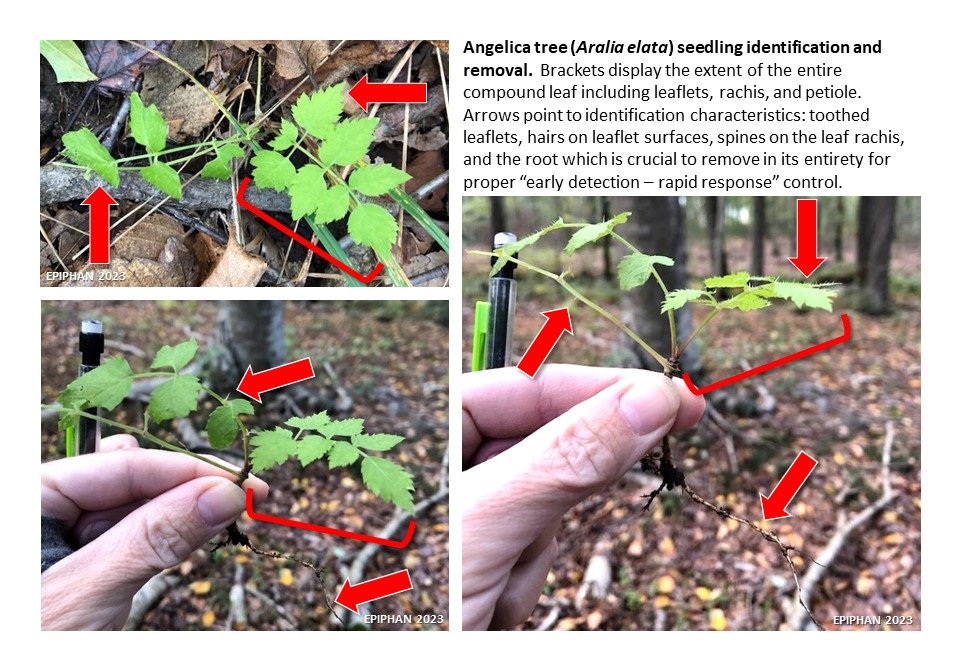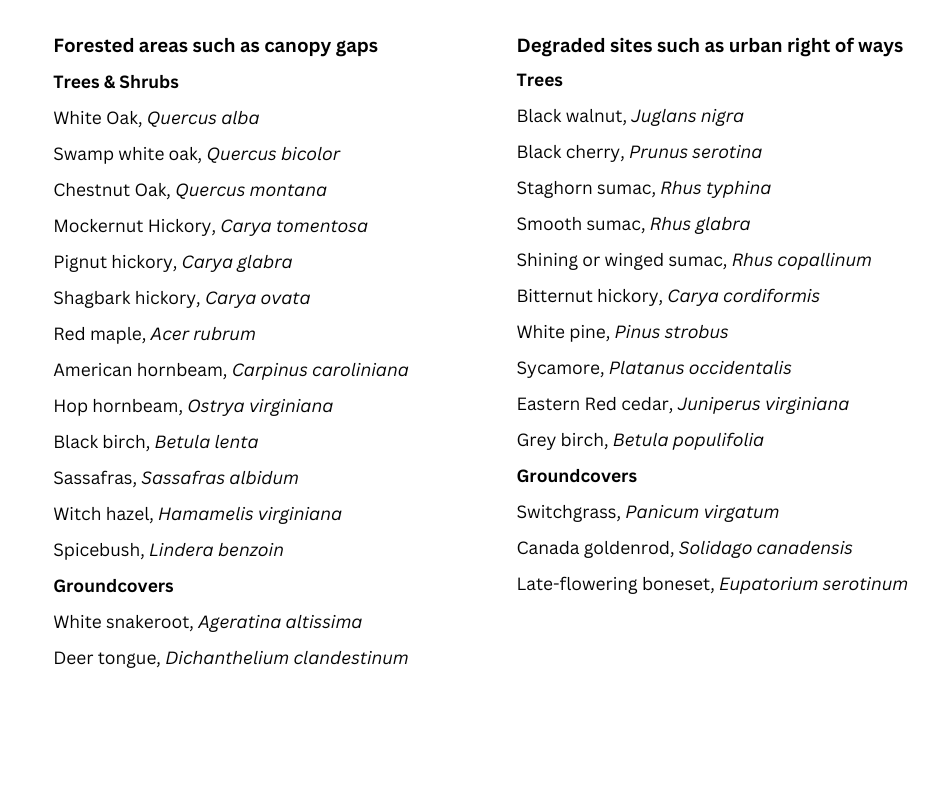Main Content


December
Angelica Tree Aralia elata
Japanese angelica tree (Aralia elata) is an extremely aggressive, fast growing, deciduous tree that invades forest canopy gaps, forest edges, and right of ways. It is a heavy seed producer and once this tree invades an area it takes over quickly, forming dense stands (Figure 1) and suppressing native vegetation that is critical for high quality habitat.
Description: Angelica tree can be identified in the winter even as a young sapling by its stems and bark that are covered in sharp spines and large leaf scars (Figure 2). It commonly grows 15 to 25 feet tall but can reach 40 feet. In the growing season, the large bipinnately compound leaves are hard to miss. They appear fern-like but have spines (Figure 3). In late summer, it has sizable, spreading clusters of small white flowers that then bear many pink to purple berries (Figure 4). Angelica tree can grow in moist to dry soil and part shade to full sun. It does well on disturbed sites as well as healthy forests.
Ecological threat: Angelica tree quickly forms a monoculture (community of just one species) and once established, shades out native vegetation. This invasive tree displaces native vegetation in the shrub and lower canopy layers, which then stifles natural species succession and reduces resources available for wildlife. Deer do not eat it as they prefer the native vegetation although buck rub is commonly seen on the rough, spiny bark.
Method of spread: Angelica tree spreads reproductively by seeds eaten and dispersed by birds. It also spreads clonally as it heavily sprouts and forms dense colonies. When cut, it will quickly resprout multiple new stems. This aggressive, competitive mechanism makes it challenging to control and manage.
Native look alike: Angelica tree is almost identical to the native (although rare in New Jersey) Devil’s walking stick (Aralia spinosa). A report by Moore et al. (2009) concluded that after looking at herbarium and field collections, almost all recent reports of Devil’s walking stick in the northeastern United States have been based on misidentification of Angelica tree.

Removal methods: Angelica tree is a heavy re-sprouter so mechanical control may only be effective on young populations. Young saplings can be dug up, being careful to remove the entire root or the plant will re-sprout. Remove the inflorescence (flower head) in the summer so it does not go to seed. Early detection/rapid response is the ideal method for control; learn to identify this tree in small seedling stages and monitor at-risk locations regularly (Figure 5).
For chemical control, basal bark treatment can be performed where an herbicide (for example triclopyr) is sprayed around the lower 12 inches of the trunk. A foliar herbicide application on the leaves (for example, a mix of glyphosate and triclopyr) is also effective when saplings are below 4 feet. One option is to cut the trees early in the season and foliar spray the short resprouts approximately 6 weeks later. On larger specimens, stem injections are effective. Anecdotal evidence suggests that cut stump treatments, where the tree is cut at the base and pesticide applied to the stump, are only effective in the winter. Additional information about control strategies is available below in the resources section. Always follow the herbicide label instructions; the label is the law. Post treatment, make sure to monitor the area for re-sprouts and new individuals for multiple seasons. Information about seed viability is limited.
If you are not able to use or comfortable with using herbicides but have an Angelica tree invasion that needs attention, hire a landscape professional that has a current pesticide license and specializes in invasive plant management.
Native alternatives: Evidence suggests that Angelica tree usually does not do well in the deep shade, so it is critical after removing this species to re-plant with native forest species at high densities to establish quick cover and prevent reinvasion. A layered approach is suggested with multiple species. Contact your local Cooperative Extension office for assistance in determining optimal native species for your site conditions. Examples of native forest species to plant in northern New Jersey include:

Is the “Invasive Species of the Month” useful to you?
Let us know how.
Additional resources and references:
- Collins, B.R. and Anderson, K.H., (1994). Plant Communities of New Jersey. A Study in Landscape Diversity. Rutgers University Press. New Brunswick. NJ
- Gerry Moore, Steven D. Glenn, and Jinshuang Ma. Distribution of the Native Aralia spinosa and Non-Native Aralia elata (Araliaceae) in the Northeastern United. States. Rhodora 111(946), 145-154, (1 April 2009). https://doi.org/10.3119/08-2.1
- Lower Hudson Partnership for Regional Invasive Species Management website. Aralia elata. Accessed on December 19, 2023 at https://www.lhprism.org/species/aralia-elata
- Rawlins, Karen. (2014). Aralia elata/NJ. BugwoodWiki website. Center for Invasive Species and Ecosystem Health at the University of Georgia. Accessed on December 19, 2023 at https://wiki.bugwood.org/Aralia_elata/NJ
- Sarver, M.J., A. Treher, L. Wilson, R. Naczi, and F.B. Kuehn, 2008. Mistaken Identity? Invasive Plants and their Native Look-alikes: an Identification Guide for the Mid-Atlantic. Dover, DE: Delaware Department of Agriculture and USDA Natural Resources Conservation Service. https://www.nybg.org/files/scientists/rnaczi/Mistaken_Identity_Final.pdf
Thank you to our reviewers: John Landau and Roslyn Dvorin.
The goal of Rutgers Cooperative Extension’s “Invasive Species of the Month” is to highlight those organisms that are non-native to New Jersey and cause economic or environmental harm, or harm to human health. We can all help prevent the spread of invasives by learning which species are a threat to our ecosystems.